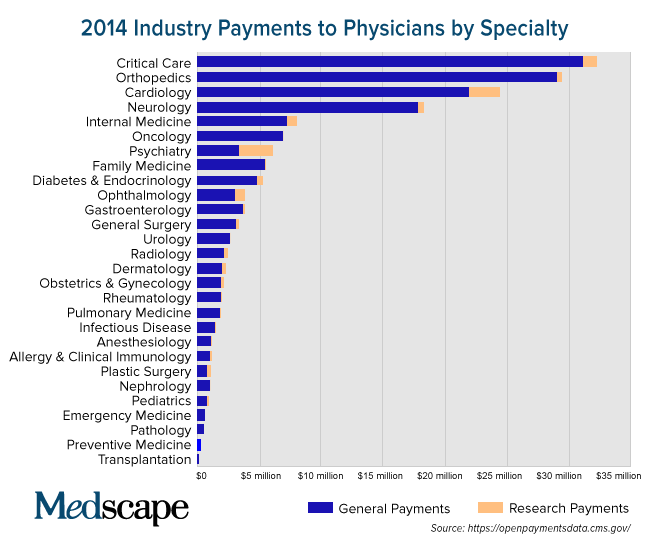UPDATED July 10, 2015 // The Centers for Medicare & Medicaid Services (CMS) on June 30 published data showing that about 1400 drug and device companies paid $6.49 billion in 2014 to more than 600,000 physicians and more than 1100 teaching hospitals. Of this amount, $3.23 billion was for research and $2.56 billion was for general purposes such as consulting and speaking fees, travel, food, and gifts.
The payments to physicians included $2.02 billion in general payments, $2.52 billion in research payments, and $703 million to physicians who owned or invested in drug and device companies. The research payments to physicians included payments to institutions where a physician was named as a principal investigator on a research project.
The hospitals received $543 million in general payments and $705 million in research payments. None of the hospitals had ownership or investment interests in any drug or device companies.
Manufacturers are not required this year to disclose payments for continuing medical education activities.
By Specialty
The breakdown of payments to individual physician specialties reveals that the top 28 subspecialties received a total of only $12.3 million in research payments. Including payments to other kinds of clinicians and ambulatory care sites, the total rises to just $127 million.
This does not surprise Aaron S. Kesselheim, MD, MPH, associate professor of medicine at Harvard Medical School and Brigham & Women's Hospital in Boston, Massachusetts. "When the physicians who work for academic medical centers and medical schools do research, the money that they receive to do the research — the funding they get — doesn't get paid to them," he told Medscape Medical News. "It gets paid to their institution, and the institution manages it. The investigator draws from that money to buy the centrifuges or recruit patients to their clinical trial or whatever they do."
The CMS report also shows that some specialties received far more than others in general payments: The top four specialties for general payments were critical care, with $31.2 million; orthopedics, $29 million; cardiology, $21.9 million; and neurology, $17.8 million. General internal medicine, in comparison, got $7.2 million, and family medicine, $5.3 million.

Dr. Kesselheim said he does not know why the drug and device companies paid so much to the four specialties cited here, but in the last 5 to 8 years, he noted, pharmaceutical companies have shifted their marketing emphasis from blockbuster drugs that primary care doctors frequently prescribe to specialty drugs that are more often prescribed by subspecialists.
"Recently, there have been a number of very broad primary care drugs that have lost their patent protection and become generic, and when they do that, drug companies stop promoting them," he said. "By contrast, a lot of the new drugs that have been produced are specialty drugs used for multiple sclerosis or other conditions that might be relevant for neurologists or cardiologists but are not prescribed by internists or family physicians. So what you might be seeing there is an evolution in the way that drug companies promote their products."
The Open Payments program, which was created by the Affordable Care Act, requires drug and device manufacturers to report transfers of value to providers. These include payments, honoraria, and research grants, as well as income from physicians' industry-related investments. The purpose of the program is to allow individuals to get information about physicians' financial relationships with the companies that make the products they prescribe or use with patients.
CMS invites physicians and teaching hospitals to review the data submitted by manufacturers. The providers who registered to do that reviewed nearly 30% of the total value of the payments reported to the government. The median value of the total payments to registered physicians was $3644 compared with $747 made to nonregistered physicians, CMS said in a news release.
Search and Ye Shall Find
Shantanu Agrawal, MD, CMS' deputy administrator and director of the agency's Center for Program Integrity, said in the release that the agency improved the Open Payments user interface after it was shut down for 2 weeks last fall to correct erroneous information about what a particular physician received from healthcare manufacturers. Other consumer website upgrades are expected in late summer, he said.
According to CMS, in this current release the agency "was able to validate that 98.8% of all records submitted in the Open Payments system contained accurate identifying information about the associated covered recipient."
The Open Payments website includes a search tool that allows anyone to search for the amount a particular company paid to providers or the amount a particular physician or hospital received.
According to Reuters, Pfizer, the largest US pharmaceutical firm, reported $234.2 million in research payments and $53.3 million in general payments. British drug maker GlaxoSmithKline reported $177.1 million in research payments and $36 million in general payments.
Boston Scientific Corp, a leading device maker, reported $18.4 million in research payments and $26.3 million in general payments. Edwards Lifesciences Corp reported $44 million in research payments and $6.8 million in general payments.
Amgen, the world's biggest biotechnology company, spent about $117 million in research payments and $23 million in general payments, Reuters reported.
Two big academic medical centers received large sums from the drug and device companies: the University of Texas MD Anderson Cancer Center took in $92.7 million in research payments and $12.4 million in general payments, and the Cleveland Clinic netted $25.1 million in research payments and $12.9 million in general payments.
This was not the first release of data on healthcare providers' financial relationships with the drug and device makers. CMS previously released data for the last 5 months of 2013. Those data showed that 1347 companies reported making total payments of $3.43 billion to physicians and hospitals.
Medscape Medical News © 2015 WebMD, LLC
Send comments and news tips to news@medscape.net.
Cite this: Drug and Device Firms Gave Clinicians $6.49B in 2014 - Medscape - Jul 02, 2015.








Comments